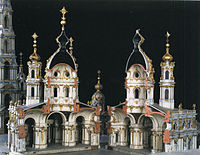Elizabethan Baroque
Smolny Cathedral | |
| Years active | 18th century |
|---|---|
| Location | Russian Empire Duchy of Courland |
Elizabethan Baroque (
Rococo style.[1] The Italian architect Francesco Bartolomeo Rastrelli is the key figure of this trend, which is still given the name 'Rastrellian Baroque'. The Russian architect Savva Chevakinsky is also a renowned figure representing this style.[2]
Style
Unlike the former Russian Baroque styles such as
Muscovite Baroque, and maintained the very essence of Russian architectural elements like the five cupolas shaped like onions
.
The Elizabethan Baroque tended to create the architecture of grandeur in order to glorify the might of the Russian Empire. Rastrelli designed majestic palace complexes in
Russian architecture of the middle of the eighteenth century. His most spectacular work is the Smolny Convent in St. Petersburg, the model he had made demonstrates the ambition of the original project that was not completed: the immense pyramidal steeple was never built.[3]
Rastrelli was influenced by the French architects
Fischer von Erlach (Vienna, Salzburg); the monasteries in Moscow; not to mention the reminiscences of Gian Lorenzo Bernini and Italian Baroque. He adapted the Italian Baroque taste to the immensity of the landscape of St. Petersburg, his art is made of an amalgam of all these styles, which he has managed to transcend into an original synthesis, more Russian than European.[4]
Apart from some interiors, it is not quite correct to regard this style as
colonnades and delicate window openings, possess the solidity of the mature Baroque rather than the curvilinear lightness of the Rococo.[2]
The Elizabethan Baroque style is also found in the works of Muscovite architects of the mid-eighteenth century, particularly those of
Saint Andrew's Church in Kiev, the style is rarely seen in Ukraine
.
After the death of the empress Elizabeth Petrovna, the construction orders were passed to Antonio Rinaldi, who had previously worked for the small courtyard of the
Baroque style and turned to the aesthetics of Classicism
.
Gallery
-
Detail of St. Nicholas Naval Cathedral
-
Red Gate in Moscow
-
St. Catherine Cathedral, Kingisepp
-
West façade of the Catherine Palace
-
Palace Chapel of the Catherine Palace
-
Detail of the Winter Palace
-
Stucco wall of the Winter Palace
-
Grand Cascade at the Peterhof Palace
-
Grand Cascade and the church
-
Church at Peterhof Palace
-
Detail of the church at Peterhof Palace
-
Detail of St. Andrew's Church
-
Iconostasis in St. Andrew's Church
References
- AA.VV. (1982). "Растрелли и проблемы барокко в архитектуре". Барокко в славянских культурах[Baroque in the Slavic Cultures: Rastrelli and Baroque Problems in Architecture] (in Russian).
- ^ a b c N. Pevsner; J. Fleming; H. Honour (1981). Dizionario di architettura [Dictionary of Architecture] (in Italian). Torino: Einaudi.
- ISBN 978-2-0705-3494-4.
... à la Néva
- ISBN 978-2-0705-3272-8.
L'allégresse italienne

















